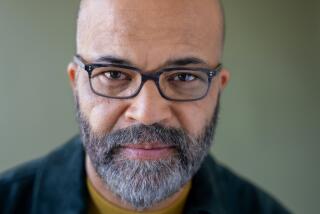The dark side of genius
- Share via
IN 1933, Ernest Hemingway took a break from hunting kudu on the Serengeti to write the introduction to “This Must Be the Place,” Jimmie Charters’ memoir about his Parisian bar, the Dingo. “Once a woman has opened a salon, it is certain that she will write her memoirs,” Hemingway wrote. “If you go to the salon you will be in the memoirs. Now a saloon, or bar, is different. You should expect to be able to go into a saloon or bar and pay for your drinks without appearing in the bartender’s memoirs, and I was shocked and grieved to hear that Jimmy [sic] Charters was writing his. It is only a step from abolishing the right of sanctuary in the Republic of San Marino to permitting bartenders to write their memoirs.”
Certainly there is no sanctuary left on the psychiatrist’s couch. Sydney Pollack’s fond documentary “Sketches of Frank Gehry” is full of rippling anecdotes by Gehry’s therapist. Now, with the publication of “The Fellowship,” Roger Friedland and Harold Zellman’s remarkable and horrifying biography of Frank Lloyd Wright, it is clear that there is no sanctuary for teachers. Friedland, a cultural sociologist, and Zellman, an architect, have tracked down and interviewed dozens of the apprentices who worked at the Taliesin Fellowship, the conservatory founded in 1932 by Wright and his third wife, Olgivanna, on his family’s property in Wisconsin. And do these apprentices have stories to tell!
For many years, through much of the Depression, the fellowship was little more than a scheme to keep Wright and Olgivanna fed and housed. Wright, born two years after the end of the Civil War, was in a midlife slump. The architect of Tokyo’s famed Imperial Hotel and designer of the revolutionary Prairie Houses was washed up. “The greatest designer of the 19th century,” quipped the young architect Philip Johnson. To his cousin Richard Lloyd Jones, Wright was “a house builder and a home wrecker” for abandoning his first wife and their six children for a mistress who was subsequently murdered along with her two children by a crazed servant in 1914.
Wright met Olgivanna in 1924 at a ballet performance in Chicago. The 27-year-old Montenegrin beauty had recently sailed from France to America to scout out possible benefactors for her Russian guru, the charismatic mystic George Ivanovitch Gurdjieff. Five years earlier, she had begun to follow Gurdjieff, hiking barefoot over the mountains of Georgia, abandoning her husband and infant daughter to sit at the feet of the master. To Olgivanna, Wright was another great man and Taliesin a rural paradise, the perfect New World haven for Gurdjieff. The fellowship would be molded around Wright, the American genius, the way Gurdjieff’s Parisian academy was molded around the Russian. Wright told Olgivanna of Victor Hugo’s “argument that the invention of movable type had enabled the book to dethrone architecture.... [Wright] would be architecture’s redeemer, a T-square-wielding Dante who would dethrone the book and restore architecture to its rightful place.” Olgivanna would be his Beatrice.
None of this was clear, of course, to the enthusiasts who applied to join the fellowship. These early apprentices received no formal instruction for their $650 annual tuition. Rather, they signed on for an indefinite period of indentured servitude, renovating Taliesin’s outbuildings to have places to sleep, as well as planting and harvesting the crops. Eventually, as clients commissioned the projects of Wright’s late, great period, the apprentices had a chance to observe at close hand Wright’s genius as a designer and engineer, even to draft and supervise some of the work. “For the Wrights, the making of men and the making of buildings were driven by the same vision, the same compulsions,” the authors contend. “Without the Fellowship, the landmarks for which Frank Lloyd Wright is best known today -- Fallingwater, Johnson Wax, the Guggenheim Museum -- would never have been created.”
Perhaps. But whatever talents these young apprentices brought to Taliesin, the fellowship was not designed to encourage their independent growth. Wright never created architects of the first or even the second rank, the way his archcompetitor Walter Gropius did at Harvard University with such proteges as Philip Johnson, I.M. Pei and Paul Rudolph. Wright’s arrogance and egotism -- “grandomania” he called it, at least when he recognized it in others -- were well known when he was alive and have been well documented since his death in 1959. Wright became the model for Howard Roark, Ayn Rand’s overreaching architect-hero in her novel “The Fountainhead.” Rand, who met Wright two years after the novel’s 1943 publication, said of Wright’s fellowship: “It was like a feudal establishment.... [The apprentices] were like medieval serfs.... We sat on a raised platform, high above the others, we ate fancy delicacies and they got fried eggs; it was a real caste system. The idea for all of it was his wife’s.”
If Wright was the Thane, Olgivanna was his Lady Macbeth, controlling even the emotional and sexual lives of the apprentices, choosing partners for the few women and encouraging the rest of the mostly male group to form homosexual clubs to release their sexual energies, much as Gurdjieff had controlled the lives of his followers in Russia and France. So it is only a short step to Friedland and Zellman’s most stunning and original claim: Without Gurdjieff, “there would have been no Taliesin Fellowship, and almost certainly no Fallingwater, no Johnson Wax or Guggenheim Museum.” Gurdjieff, they argue, is the origin of all that was great and all that was awful in Wright’s world.
Without Gurdjieff, Wright and Olgivanna certainly would not have ruined some of the lives closest to theirs. When Olgivanna came to Taliesin, she brought her daughter from an earlier marriage, Svetlana. Ten years later, Svetlana eloped with Wright’s best apprentice, Wes Peters. Eventually reconciled with Wright and her mother, Svetlana bore two children, before dying in a car accident. Twenty years later, the world news trumpeted the defection to the U.S. of another Svetlana, Svetlana Alliluyeva, the daughter of Joseph Stalin. Olgivanna wooed Alliluyeva to Taliesin and engineered a marriage between her and the widowed Peters. Alliluyeva eventually realized that Olgivanna had manipulated her as much for the money she’d earned for a book contract as for her mystical attachment to Olgivanna’s dead daughter.
Even more horrifying is the story of Wright and Olgivanna’s only child, Iovanna, whom the authors interviewed in a Pasadena treatment center for the depressed and addicted. Her descent into mental illness, exacerbated by Wright, Olgivanna, Gurdjieff and many of the apprentices, is the saddest of the many sad stories in “The Fellowship.” It is little surprise that Iovanna’s favorite childhood story was Poe’s “The Fall of the House of Usher.”
Should one trust the recollections of a delusional daughter, the selective memories of forgotten apprentices, the anecdotes collected nearly 50 years after Wright’s death? Perhaps not individually. Yet the choral effect of all these voices is hard to ignore. Wright’s buildings will inevitably fall one day, like those of the poet Shelley’s “Ozymandias,” if not of Roderick Usher. But for their crimes against family and the fellowship, this T-square-wielding Dante and his Beatrice may roast in the inferno forever. *
More to Read
Sign up for our Book Club newsletter
Get the latest news, events and more from the Los Angeles Times Book Club, and help us get L.A. reading and talking.
You may occasionally receive promotional content from the Los Angeles Times.










